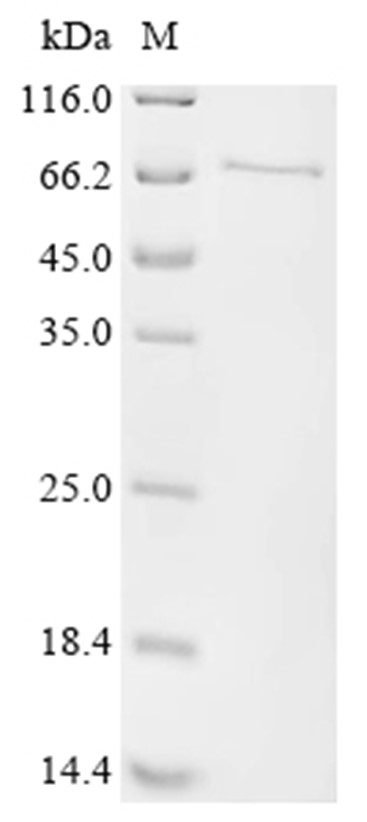 您的购物车当前为空
您的购物车当前为空
OGT Protein, Human, Recombinant (His & SUMO)
一键复制产品信息货号 TMPH-00009
别名 UDP-N-acetylglucosamine--peptide N-acetylglucosaminyltransferase 110 kDa subunit, O-linked N-acetylglucosamine transferase 110 kDa subunit (OGT), OGT, O-GlcNAc transferase subunit p110
OGT Protein, Human, Recombinant (His & SUMO) is expressed in E. coli expression system with N-6xHis-SUMO tag. The predicted molecular weight is 62.5 kDa and the accession number is O15294.


为众多的药物研发团队赋能,
让新药发现更简单!
OGT Protein, Human, Recombinant (His & SUMO)
一键复制产品信息货号 TMPH-00009 别名 UDP-N-acetylglucosamine--peptide N-acetylglucosaminyltransferase 110 kDa subunit, O-linked N-acetylglucosamine transferase 110 kDa subunit (OGT), OGT, O-GlcNAc transferase subunit p110
OGT Protein, Human, Recombinant (His & SUMO) is expressed in E. coli expression system with N-6xHis-SUMO tag. The predicted molecular weight is 62.5 kDa and the accession number is O15294.
| 规格 | 价格 | 库存 | 数量 |
|---|---|---|---|
| 5 μg | ¥ 476 | 3日内发货 | |
| 10 μg | ¥ 775 | 现货 | |
| 20 μg | ¥ 1,320 | 20日内发货 | |
| 50 μg | ¥ 1,970 | 20日内发货 | |
| 100 μg | ¥ 2,680 | 20日内发货 | |
| 200 μg | ¥ 4,160 | 20日内发货 | |
| 500 μg | ¥ 7,490 | 20日内发货 | |
| 1 mg | ¥ 11,700 | 20日内发货 |
库存状态实时更新,以官网显示为准,现货产品可直接加购物车下单
大包装 & 定制
加入购物车
TargetMol的所有产品仅用作科学研究或药证申报,不能被用于人体,我们不向个人提供产品和服务。请您遵守承诺用途,不得违反法律法规规定用于任何其他用途。
产品介绍
生物活性
化学信息
储存&溶解度
| 产品描述 | OGT Protein, Human, Recombinant (His & SUMO) is expressed in E. coli expression system with N-6xHis-SUMO tag. The predicted molecular weight is 62.5 kDa and the accession number is O15294. |
| 生物活性 | Activity has not been tested. It is theoretically active, but we cannot guarantee it. If you require protein activity, we recommend choosing the eukaryotic expression version first. |
| 研究背景 | Catalyzes the transfer of a single N-acetylglucosamine from UDP-GlcNAc to a serine or threonine residue in cytoplasmic and nuclear proteins resulting in their modification with a beta-linked N-acetylglucosamine (O-GlcNAc). Glycosylates a large and diverse number of proteins including histone H2B, AKT1, EZH2, PFKL, KMT2E/MLL5, MAPT/TAU and HCFC1. Can regulate their cellular processes via cross-talk between glycosylation and phosphorylation or by affecting proteolytic processing. Probably by glycosylating KMT2E/MLL5, stabilizes KMT2E/MLL5 by preventing its ubiquitination. Involved in insulin resistance in muscle and adipocyte cells via glycosylating insulin signaling components and inhibiting the 'Thr-308' phosphorylation of AKT1, enhancing IRS1 phosphorylation and attenuating insulin signaling. Involved in glycolysis regulation by mediating glycosylation of 6-phosphofructokinase PFKL, inhibiting its activity. Component of a THAP1/THAP3-HCFC1-OGT complex that is required for the regulation of the transcriptional activity of RRM1. Plays a key role in chromatin structure by mediating O-GlcNAcylation of 'Ser-112' of histone H2B: recruited to CpG-rich transcription start sites of active genes via its interaction with TET proteins (TET1, TET2 or TET3). As part of the NSL complex indirectly involved in acetylation of nucleosomal histone H4 on several lysine residues. O-GlcNAcylation of 'Ser-75' of EZH2 increases its stability, and facilitating the formation of H3K27me3 by the PRC2/EED-EZH2 complex. Regulates circadian oscillation of the clock genes and glucose homeostasis in the liver. Stabilizes clock proteins ARNTL/BMAL1 and CLOCK through O-glycosylation, which prevents their ubiquitination and subsequent degradation. Promotes the CLOCK-ARNTL/BMAL1-mediated transcription of genes in the negative loop of the circadian clock such as PER1/2 and CRY1/2. O-glycosylates HCFC1 and regulates its proteolytic processing and transcriptional activity. Regulates mitochondrial motility in neurons by mediating glycosylation of TRAK1. Glycosylates HOXA1. O-glycosylates FNIP1.; the mitochondrial isoform (mOGT) is cytotoxic and triggers apoptosis in several cell types including INS1, an insulinoma cell line. |
| 种属 | Human |
| 表达系统 | E. coli |
| 标签 | N-6xHis-SUMO |
| 蛋白编号 | O15294 |
| 氨基酸序列 | MAEANHFIDLSQIPCNGKAADRIHQDGIHILVNMNGYTKGARNELFALRPAPIQAMWLGYPGTSGALFMDYIITDQETSPAEVAEQYSEKLAYMPHTFFIGDHANMFPHLKKKAVIDFKSNGHIYDNRIVLNGIDLKAFLDSLPDVKIVKMKCPDGGDNADSSNTALNMPVIPMNTIAEAVIEMINRGQIQITINGFSISNGLATTQINNKAATGEEVPRTIIVTTRSQYGLPEDAIVYCNFNQLYKIDPSTLQMWANILKRVPNSVLWLLRFPAVGEPNIQQYAQNMGLPQNRIIFSPVAPKEEHVRRGQLADVCLDTPLCNGHTTGMDVLWAGTPMVTMPGETLASRVAASQLTCLGCLELIAKNRQEYEDIAVKLGTDLEYLKKVRGKVWKQRISSPLFNTKQYTMELERLYLQ |
| 蛋白构建 | 606-1022 aa |
| 蛋白纯度 | > 90% as determined by SDS-PAGE.  |
| 缓冲液 | Tris-based buffer, 50% glycerol |
| 复溶方法 | A Certificate of Analysis (CoA) containing reconstitution instructions is included with the products. Please refer to the CoA for detailed information. |
| 别名 | UDP-N-acetylglucosamine--peptide N-acetylglucosaminyltransferase 110 kDa subunit, O-linked N-acetylglucosamine transferase 110 kDa subunit (OGT), OGT, O-GlcNAc transferase subunit p110 |
| 内毒素 | < 1.0 EU/μg of the protein as determined by the LAL method. |
| 分子量 | 62.5 kDa (predicted) |
| 运输方式 | In general, Lyophilized powders are shipping with blue ice. Solutions are shipping with dry ice. |
| 存储 | Lyophilized powders can be stably stored for over 12 months, while liquid products can be stored for 6-12 months at -80°C. For reconstituted protein solutions, the solution can be stored at -20°C to -80°C for at least 3 months. Please avoid multiple freeze-thaw cycles and store products in aliquots. |
计算器
剂量转换
对于不同动物的给药剂量换算,您也可以参考 更多
技术支持
请阅读 重组蛋白用户指南 了解更多具体信息.
Related Tags: buy OGT Protein, Human, Recombinant (His & SUMO) | purchase OGT Protein, Human, Recombinant (His & SUMO) | OGT Protein, Human, Recombinant (His & SUMO) cost | order OGT Protein, Human, Recombinant (His & SUMO) | OGT Protein, Human, Recombinant (His & SUMO) chemical structure | OGT Protein, Human, Recombinant (His & SUMO) molecular weight




 很棒
很棒
 |
|